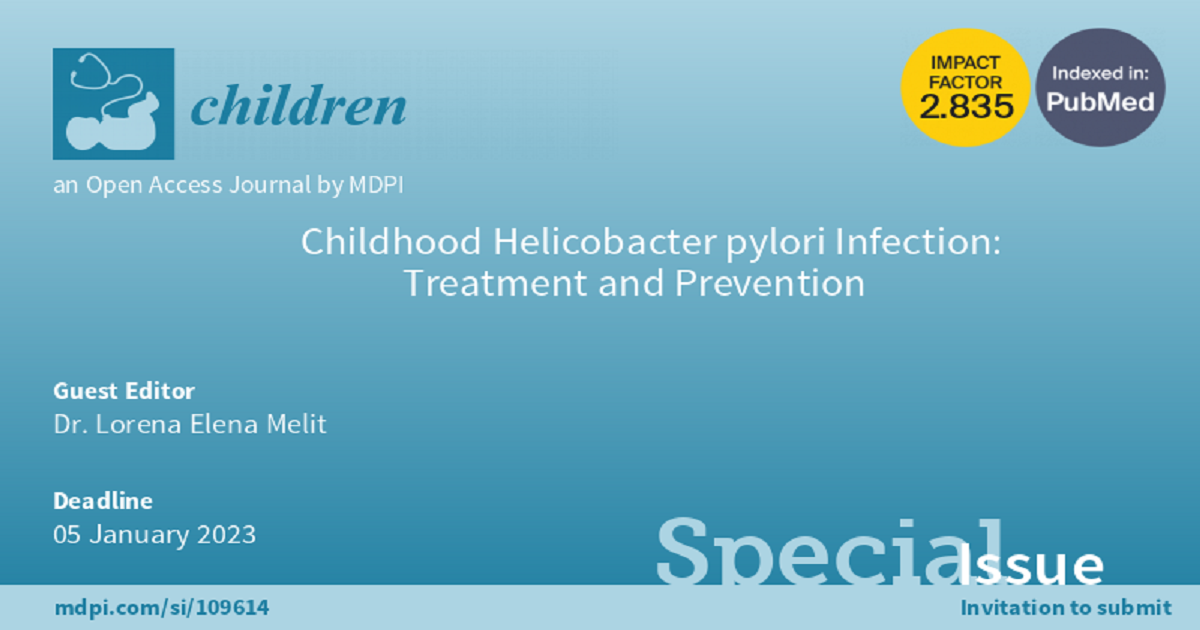Childhood Helicobacter pylori Infection: Treatment and Prevention
A special issue of Children (ISSN 2227-9067). This special issue belongs to the section "Global Pediatric Health".
Deadline for manuscript submissions: closed (5 January 2023) | Viewed by 64897

Special Issue Editor
Interests: pediatrics; pediatric gastroenterology; nutrition; helicobacter pylori infection
Special Issues, Collections and Topics in MDPI journals
Special Issue Information
Dear Colleagues,
As we all know, Helicobacter pylori is the most common infection worldwide and associated with an increased risk of gastric cancer, being defined as a class I carcinogen by the World Health Organization. This infection is usually acquired during childhood, and if left untreated its persistence into adulthood is imminent. The development of effective prophylactic and therapeutic strategies represents a crucial need in pediatrics, being the single opportunity to decrease the incidence of gastric carcinogenesis during adulthood. Considering the complex pathway from simple infection towards gastric carcinogenesis, influenced by both host and bacterial features, multidisciplinary teamwork is required in order to clearly define the role of each component in this process and to face the challenge of preventing or successfully treating this infection.
Dr. Lorena Elena Melit
Guest Editor
Manuscript Submission Information
Manuscripts should be submitted online at www.mdpi.com by registering and logging in to this website. Once you are registered, click here to go to the submission form. Manuscripts can be submitted until the deadline. All submissions that pass pre-check are peer-reviewed. Accepted papers will be published continuously in the journal (as soon as accepted) and will be listed together on the special issue website. Research articles, review articles as well as short communications are invited. For planned papers, a title and short abstract (about 250 words) can be sent to the Editorial Office for assessment.
Submitted manuscripts should not have been published previously, nor be under consideration for publication elsewhere (except conference proceedings papers). All manuscripts are thoroughly refereed through a single-blind peer-review process. A guide for authors and other relevant information for submission of manuscripts is available on the Instructions for Authors page. Children is an international peer-reviewed open access monthly journal published by MDPI.
Please visit the Instructions for Authors page before submitting a manuscript. The Article Processing Charge (APC) for publication in this open access journal is 2400 CHF (Swiss Francs). Submitted papers should be well formatted and use good English. Authors may use MDPI's English editing service prior to publication or during author revisions.
Keywords
- helicobacter pylori
- pediatrics
- gastritis
- treatment
- prevention
Benefits of Publishing in a Special Issue
- Ease of navigation: Grouping papers by topic helps scholars navigate broad scope journals more efficiently.
- Greater discoverability: Special Issues support the reach and impact of scientific research. Articles in Special Issues are more discoverable and cited more frequently.
- Expansion of research network: Special Issues facilitate connections among authors, fostering scientific collaborations.
- External promotion: Articles in Special Issues are often promoted through the journal's social media, increasing their visibility.
- Reprint: MDPI Books provides the opportunity to republish successful Special Issues in book format, both online and in print.
Further information on MDPI's Special Issue policies can be found here.






